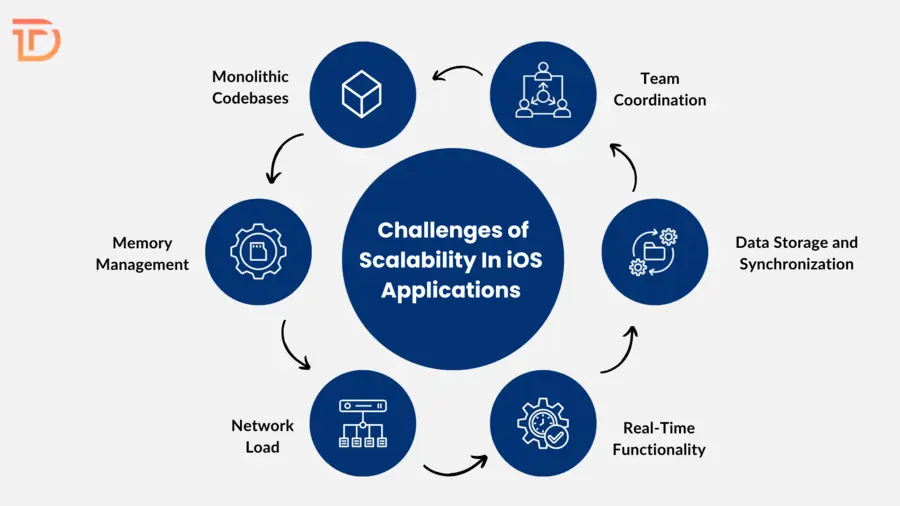The demand for mobile apps is skyrocketing, and users now expect lightning-fast performance, real-time personalization, and constant updates. Businesses that want to stay relevant are building iOS applications that not only solve a problem but grow with their user base. The challenge lies in ensuring that these apps perform smoothly even as their user count, features, and complexity increase, making scalability essential. Developers today are expected to do more than just code working apps. They need to future-proof them by using modern design patterns, scalable infrastructure, efficient data handling, and proactive performance strategies. An app may function perfectly for a few hundred users, but without proper scaling techniques, the same app might crash, slow down, or even fail once its user base multiplies. In this blog, we will uncover the fundamentals of scalability, why it matters in iOS development, what the app landscape looks like in 2025, and the advanced strategies that can help apps evolve without breaking.
Understanding Scalability for iOS Apps
Scalability in mobile development refers to an application’s ability to handle increased demand, user traffic, and feature updates without compromising performance. A scalable iOS app works just as efficiently for a hundred users as it does for a million. It allows businesses to expand, add new capabilities, and grow their digital footprint without needing to rebuild their product from scratch.
Scalability is rooted in smart architecture and efficient resource management. Scalable apps rely on modular systems where individual components can evolve independently. They allow developers to isolate functionality and optimize specific parts of the codebase without affecting the entire application. A well-scaled app is easy to maintain, extend, and deploy across different devices and user groups.
Such apps also prepare for spikes in usage, server load, and user interactions by distributing resources intelligently. Whether you are integrating AI features, supporting offline functionality, or enabling real-time notifications, scalability ensures the app adapts to meet user expectations as they change over time.
Why is Scalability Important for iOS Apps?
Scalability ensures that an app continues to deliver a fast and seamless user experience even as it grows. Without a scalable foundation, an iOS app might fail to accommodate new users, additional features, or expanding datasets. That often leads to slower loading times, frequent crashes, and frustrated users.
Poorly scaled apps can also increase costs over time. Maintaining an app that isn’t built to scale often requires more effort, manual fixes, and complete reworks. Scalable architecture, on the other hand, supports consistent performance, easier updates, and faster innovation cycles. As business needs evolve, so should the app—without having to start from square one every time.
Scalability also impacts the ability to launch globally. Apps that are designed to handle load and support different network environments can serve users across countries and time zones, helping businesses expand their reach.
iOS App Growth in 2025
As per a report by Statista, the number of iOS apps released worldwide reached around 1.6 million in 2024, and the trend is expected to grow through 2025. The Apple App Store continues to be one of the most competitive platforms for developers, with thousands of new apps added monthly. The surge in app development reflects the increasing reliance on mobile solutions for everything from banking to entertainment.
Such a high rate of growth puts immense pressure on developers to ensure that their apps stand out—not just in terms of design but also in terms of performance, reliability, and scalability. As more users download and interact with iOS apps daily, scalable design becomes a critical success factor.
Challenges of Scalability In iOS Applications
While scalability offers long-term benefits, implementing it in iOS apps can be complex. Developers face several roadblocks when trying to prepare their applications for future growth. The key challenges often encountered are:

Monolithic Codebases
Large applications often have tightly coupled components that depend heavily on one another. This design makes scalability difficult, as a small change in one module can unexpectedly affect others. Debugging and updating such systems require extra effort, slowing down innovation and increasing the risk of regression bugs during feature rollouts.
Memory Management
Apps with complex features, animations, or media consumption must manage memory efficiently. Poor memory handling leads to crashes, battery drainage, and lag, especially on older iOS devices. Scalable apps must use strategies like lazy loading, object reuse, and memory profiling to ensure smooth performance across different hardware specifications.
Network Load
iOS applications that frequently make API requests can struggle under heavy traffic. Without proper caching, load balancing, and retry mechanisms, user experience suffers due to timeouts and delays. Scalable apps minimize server dependency using background tasks, response caching, and graceful degradation during poor or inconsistent network connectivity.
Real-Time Functionality
Features such as chat, multiplayer gaming, or live updates require real-time data processing and instant synchronization across users. Supporting these demands at scale involves using efficient protocols like WebSockets, background refresh APIs, and smart data syncing to ensure messages or data arrive quickly and accurately, regardless of user count.
Data Storage and Synchronization
Handling large volumes of structured and unstructured data becomes challenging as users grow. Data must sync across devices reliably, even with intermittent connectivity. Using databases like Core Data with CloudKit or Realm allows scalable storage, background syncing, and conflict resolution, helping maintain data integrity and seamless multi-device experiences.
Team Coordination
Larger development teams often deal with code merging issues, inconsistent styles, and unclear responsibilities. Without scalable team workflows, app development slows down. Implementing version control systems, automated testing, clear code architecture, and modular development workflows supports better collaboration and faster iteration cycles across growing teams and features.
Advanced Techniques in iOS App Development
Building scalable iOS apps requires more than just best practice. Developers need to adopt advanced tools and strategies that allow apps to grow intelligently. A few important advancements that help in improving scalability include:

Modular Architecture
Modular architecture breaks an app into isolated, interchangeable components that can evolve independently. Using patterns like MVVM, VIPER, or Clean Architecture allows teams to scale faster by updating, testing, or replacing individual modules without affecting the rest of the system. This leads to reduced bugs, improved development speed, and easier onboarding for new developers.
Asynchronous Programming
Apps must stay responsive, even when performing heavy tasks such as data fetching or file processing. Using Swift’s async/await model or Grand Central Dispatch, developers run long processes in the background while keeping the main thread free. This ensures smooth scrolling, animations, and navigation, even under load, which is critical for user experience at scale.
Cloud Integration
Cloud platforms like Firebase, AWS, and Google Cloud support elastic scaling by adjusting computing resources as user demand grows. Developers can use serverless functions, scalable databases, and cloud storage to handle authentication, notifications, and backend logic. This approach reduces infrastructure management and ensures app performance remains consistent across regions, time zones, and user loads.
Caching Strategies
Repeated data requests can slow down apps and increase server strain. Caching strategies using NSCache, Core Data, or Realm allow frequently accessed content to be stored locally, improving speed and reducing bandwidth usage. For apps with high media content, libraries like SDWebImage and Kingfisher ensure smooth image loading, even on poor network connections.
Scalable APIs
API design should support high traffic and large data loads. Implementing pagination, rate limiting, and response compression reduces server stress. Using GraphQL allows apps to fetch exactly the data needed, minimizing over-fetching. Scalable APIs also support microservices, which separate logic into independent endpoints for better maintenance, updates, and load distribution.
Automated Testing and CI/CD Pipelines
Maintaining quality while scaling requires frequent testing. Unit, UI, and performance tests help catch issues early. Tools like XCTest, Fastlane, and GitHub Actions automate testing and deployment. CI/CD pipelines ensure that updates are rolled out faster, with fewer bugs, helping teams scale app features without disrupting the user experience or introducing regressions.
Code Reusability and Swift Packages
Reusable code helps scale apps efficiently across different projects or components. Swift Packages allow developers to write shared logic, UI components, or utility libraries once and integrate them across multiple apps. This improves consistency, reduces redundancy, and speeds up development while keeping the codebase cleaner, more maintainable, and easier to test at scale.
Data Synchronization
Synchronizing user data across devices and sessions is vital as apps scale. Using databases like Core Data with CloudKit or Realm enables real-time data syncing, background updates, and offline support. Conflict resolution and version tracking ensure consistency and integrity, even when users interact with the app from multiple devices or under unstable connections.
Localization and Regional Scaling
To grow globally, apps must support multiple languages, currencies, and region-specific features. iOS provides localization tools that allow dynamic loading of assets, language packs, and UI adaptations. A scalable app anticipates regional laws, user preferences, and formats, making it easy to deploy localized versions without building separate codebases for each target market.
User-Centric Analytics and Scaling
Understanding user behavior helps identify which features to optimize or scale first. Tools like Firebase Analytics and Mixpanel provide insights into usage patterns, drop-offs, and feature popularity. Analyzing this data enables smarter decisions on resource allocation, infrastructure planning, and feature rollout strategies, ensuring that app growth aligns with real user needs and expectations.
Wrapping Up
Scalability is not a feature that can be bolted on later. It is a design philosophy that shapes how an app is built, deployed, and maintained. With millions of apps flooding the market and user expectations constantly rising, iOS developers must plan for growth from day one. Custom iOS app development services focus on implementing scalable architecture, asynchronous data handling, cloud services, and efficient caching techniques to ensure apps remain fast, reliable, and flexible. The ability to scale seamlessly can make the difference between an app that thrives and one that fails under pressure.
Being a custom mobile application development company, Dreamer Technoland delivers future-ready iOS applications that are built for performance and scalability. Our developers specialize in creating modular, cloud-integrated apps that grow with your user base. We use modern architectures, automated testing, and custom backend solutions to ensure your app stays responsive and adaptable. Whether you’re launching a startup MVP or scaling an enterprise app, we help you deliver powerful mobile solutions that perform flawlessly, even under heavy load.







